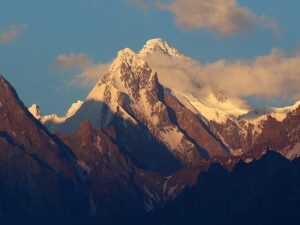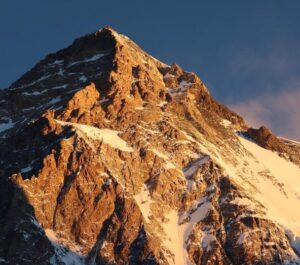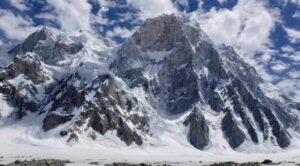At 7,401m, Ghent Kangri is the third highest mountain in the Karakoram’s Saltoro Mountains, on the border between Pakistan and India. Surrounded by glaciers, the Saltoros are 50km long and 30km wide.
In 1961, an Austrian team took on Ghent Kangri. They endured morale-sapping soft snow, an episode of delirium, and three aborted summit pushes.

Saltoro Kangri (7,742m), K12 (7,428m), and Ghent Kangri (7,401m). Photo: Mountain on Earth
First expeditions
British explorer William Moorcroft partially scouted the area around Ghent Kangri in 1821. A procession of explorers followed, including the great American geographer, cartographer, explorer, and mountaineer, Fanny Bullock Workman, and her husband William Hunter Workman in 1911. In 1935, British climber James Waller led an expedition to Saltoro Kangri, but they failed to reach the summit. In 1957, legendary mountaineer Eric Shipton also explored the area.

Eric Shipton led an expedition to the Siachen Glacier in 1957. Photo: Otedslpipex
Besides Ghent Kangri, the other major peaks in the range include Saltoro Kangri (7,742m), Sherpi Kangri (7,303m), and Silver Throne (6,600m). None of these mountains had been climbed until 1960 when Austrian Ernst Senn and German Michael Anderl crowned the Silver Throne.

Fanny Bullock Workman on the Silver Throne plateau, with a newspaper that reads Votes for Women. Workman and her husband named Ghent Kangri in 1912. Photo: Wikimedia
1961, the Austrians arrive
In March 1961, an Austrian team left Vienna for Pakistan. Originally, they wanted to climb Saltoro Kangri, but they were denied permission for this peak. Instead, they had a choice between three other mountains in the area. Eventually, they settled on Ghent Kangri.

Ghent Kangri. Photo: Capricorn Worlds of Wonder
On May 3, 1961, after a long journey, they arrived in Base Camp with their Pakistani porters. The team was led by Erich Waschak, and included Karl Ambichl, Wolfgang Axt, Raimund Heinzel, and Ignaz Obermiller. Sirdar Ghulam Rasul assisted them, along with Mohammed Hussein and a liaison officer.

The beautiful Saltoro Kangri (7,742m), climbed for the first time on July 24, 1962, by a Japanese-Pakistani expedition. Photo: Rizwan Saddique
The group chose the West Ridge, and established camps step by step: Base Camp at 4,150m, Camp 1 at 4,500m, Camp 2 at 5,200m, Camp 3 at 6,000m, and Camp 4 at 6,400m. They set up Camp 4 on May 22.
The distance between Base Camp and Camp 4 was 34km, including 23km on the Kondus Glacier. They had to stick to this mammoth trek because government guidelines only allowed them to access the mountain via this glacier.

The Kondus Glacier. Photo: Massimo Faletti
Three aborted summit pushes
Three times, bad weather forced the team to retreat from their high camp. The climbers suffered from several injuries and accidents. Waschak pragmatically summed them up, as if from a shopping list: “Two falls into crevasses, one fracture of ribs, one bruised chest, one snowblindness, one beginning pneumonia. However, without major complications.”

The Saltoro Range is bordered in the north by Sia La, in the south by the Bilafond Glacier, in the west by the Kondus Glacier, and in the east by the Siachen Glacier. Photo: Cultura de Montania
The group made a fourth summit attempt on June 3. Earlier, Heinzel and Waschak had turned back from Camp 2 because they felt unwell. Now three remained: Axt, Ambichl, and Obermiller.
On June 3, the trio left Camp 2 at 2:30 am. The snow conditions were really bad. In deep, soft snow and unbearable heat, they managed to reach Camp 3. Ambichl and Obermiller stayed there, but Axt, the youngest on the team, continued toward Camp 4.
The distance between Camp 2 and Camp 4 was a long, 14km slog. When Axt reached Camp 4 at 1 pm, he had to dig the tent out of the snow and repair it. The weather forecast promised two fair days before the arrival of the monsoon.

Wolfgang Axt. Before Ghent Kangri, he and Raimund Henzel made the second ascent of Silver Throne. Photo: Alpenklub
Victory or defeat?
Alone in Camp 4, Axt could not sleep. Another 1,000m separated him from the summit, and he decided that he would attempt it solo. He knew how hard everyone had worked and he felt responsible for the success or failure of the group.
Ahead, he saw two very difficult obstacles: a section of rocks and some scary ice cliffs. At 2 am on June 4, he set off. Dawn broke as he reached the rocks. Ground conditions were bad. Sometimes, he found powder snow; other times, hard ice. At around 9 am he managed to reach the vertical ice wall.
He got over it but could barely breathe from lack of oxygen. He threw himself into the deep snow to rest.

Wolfgang Axt. Photo: Archiv Ambros Aichhorn
He was still 300m from the top. With a lot of self-discipline, he gathered his strength and continued up. But one more trial awaited; the monsoon arrived earlier than expected, and stormy weather engulfed him. Now, Axt could barely see or breathe.
Somehow, at 12:30 pm, he made the 7,401m summit.
A dangerous daydream
Hypoxia and fatigue began to play tricks on him. He could no longer distinguish between reality and fantasy. He saw a beautiful beach, palm trees, and a blue sea. Aware that this could spell death, he concentrated on the mountains in the distance: K2, Nanga Parbat, Hidden Peak, and Broad Peak.
He planted the Austrian and Pakistani flags on top. Then with great effort, he took out his camera to certify his summit. With difficulty, he began to descend. Axt made Camp 4 at 5 pm, where Obermiller and Ambichl were waiting for him. They congratulated Axt and made him a good soup.
At just 25, Axt had become the first person to ascend Ghent Kangri.

Ghent Kangri features a double peak. About a kilometre northeast of the main peak lies Ghent Kangri II. Only a handful of others have climbed here after its first ascent. Photo: Rizwan Saddique






